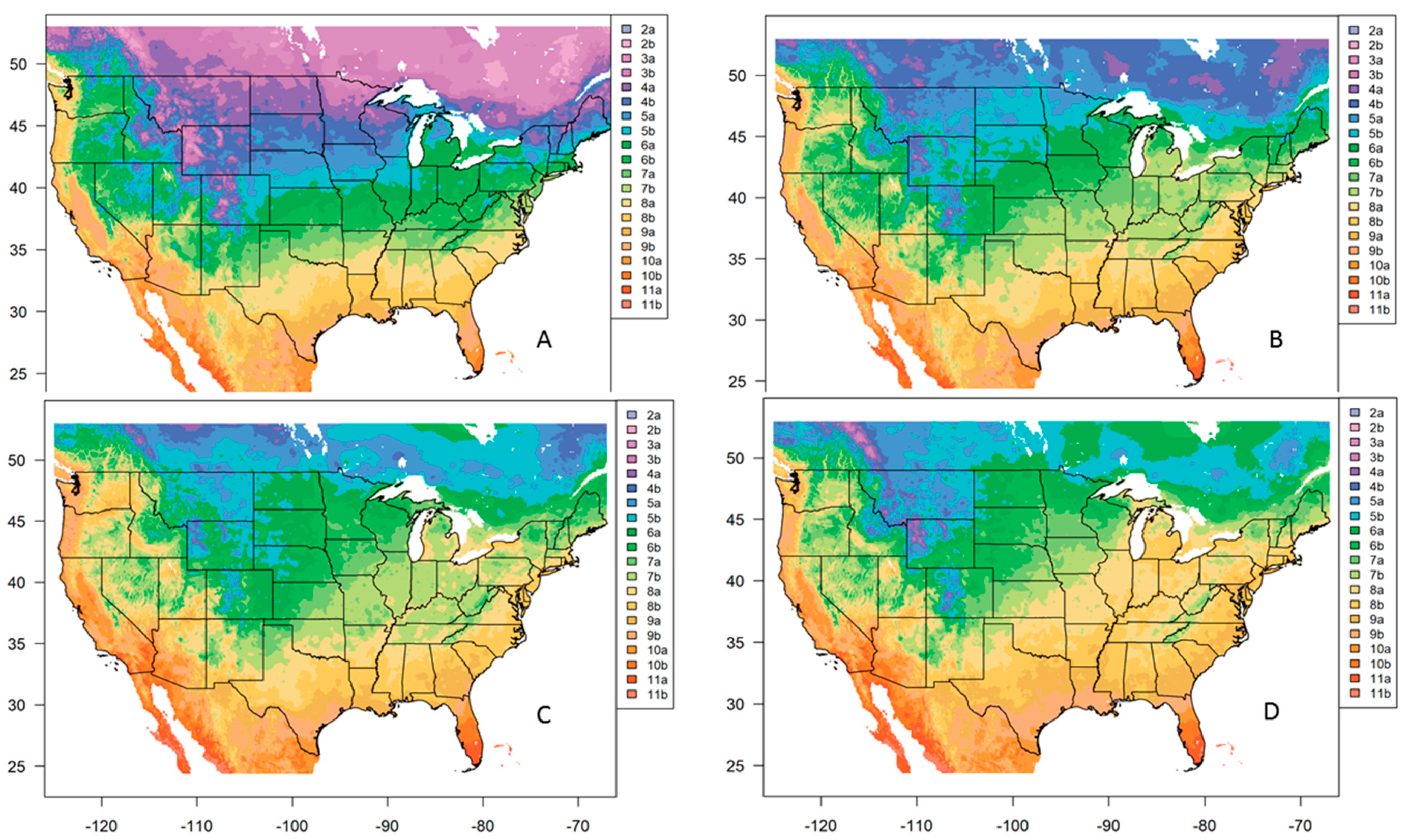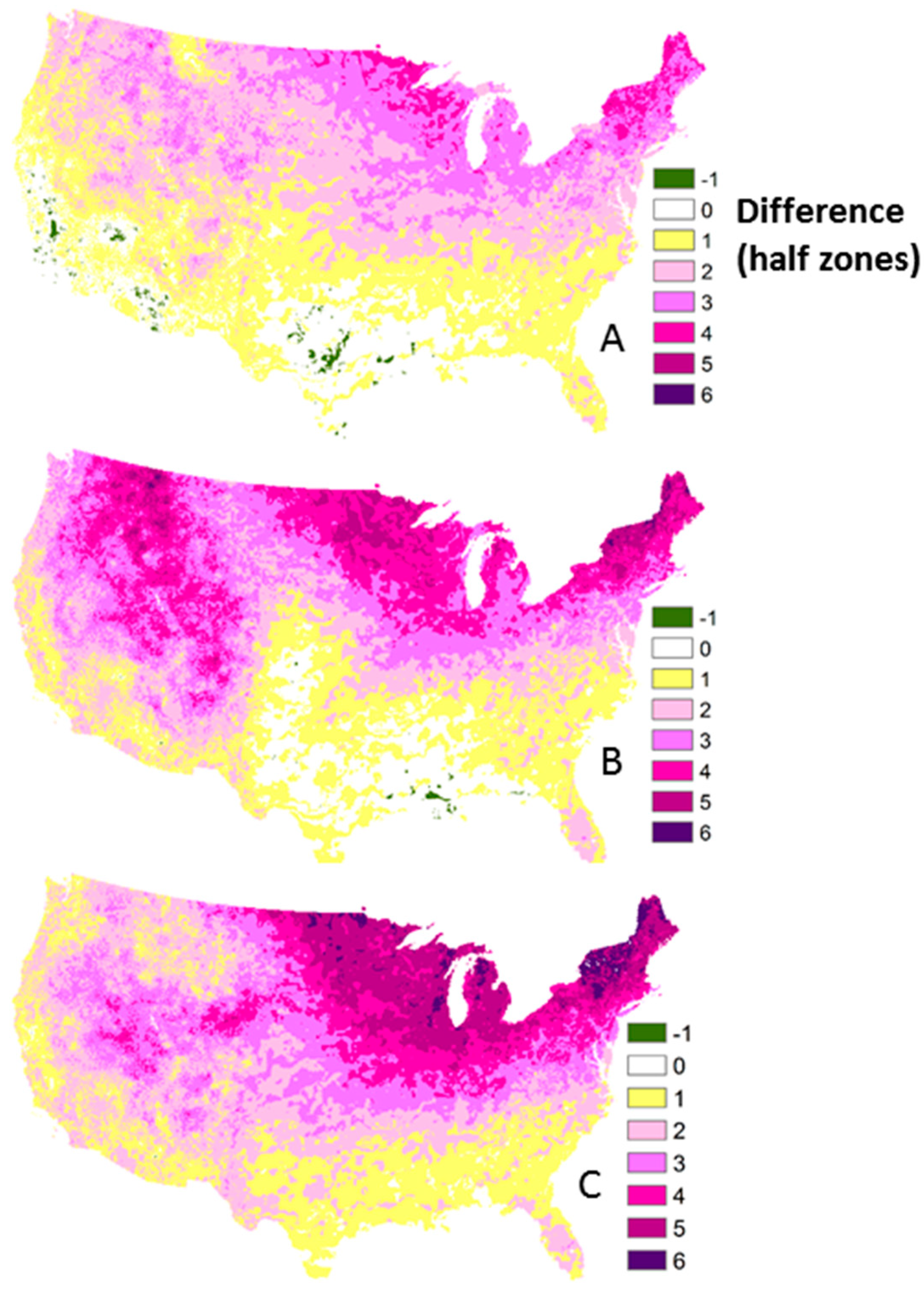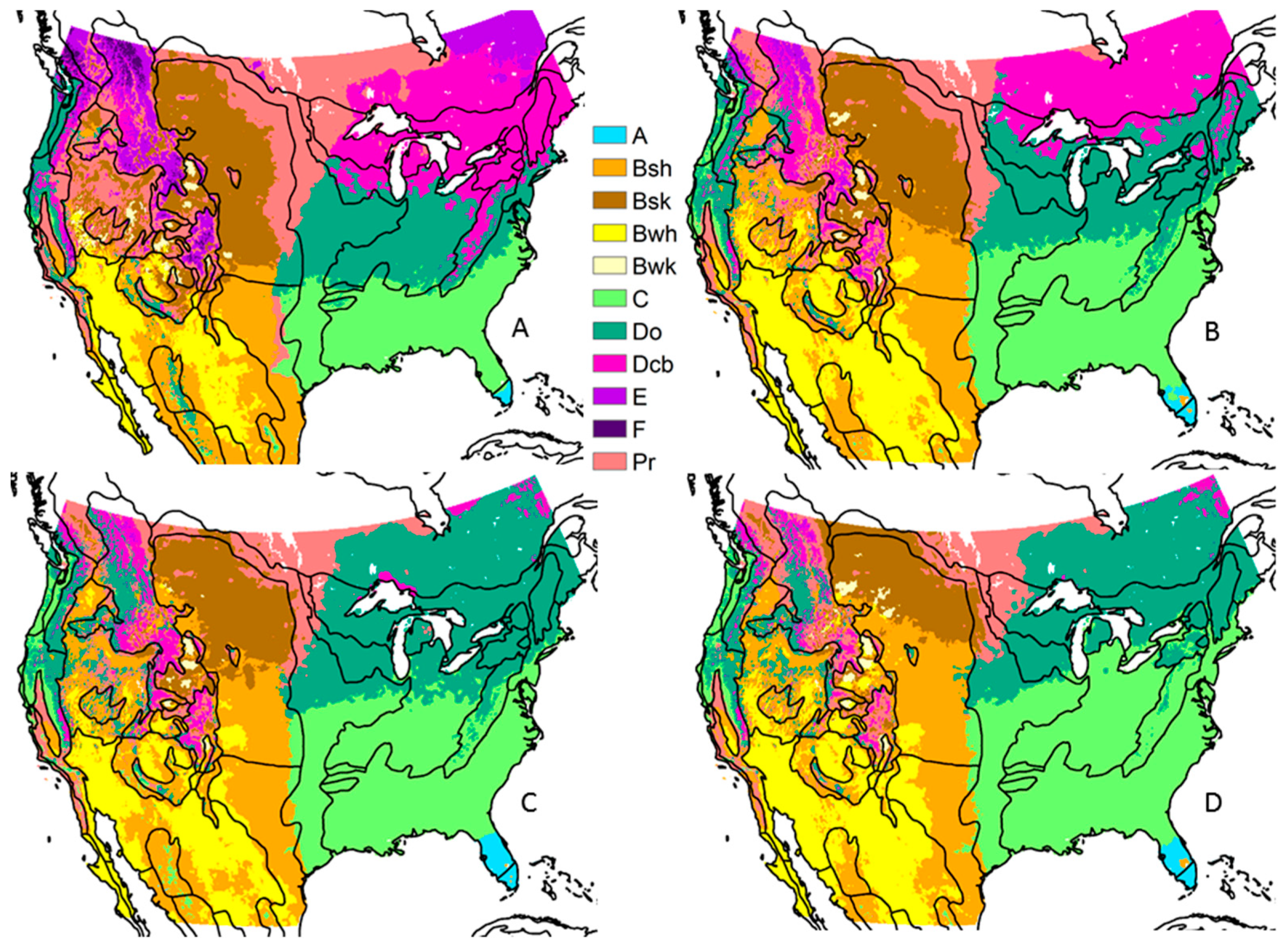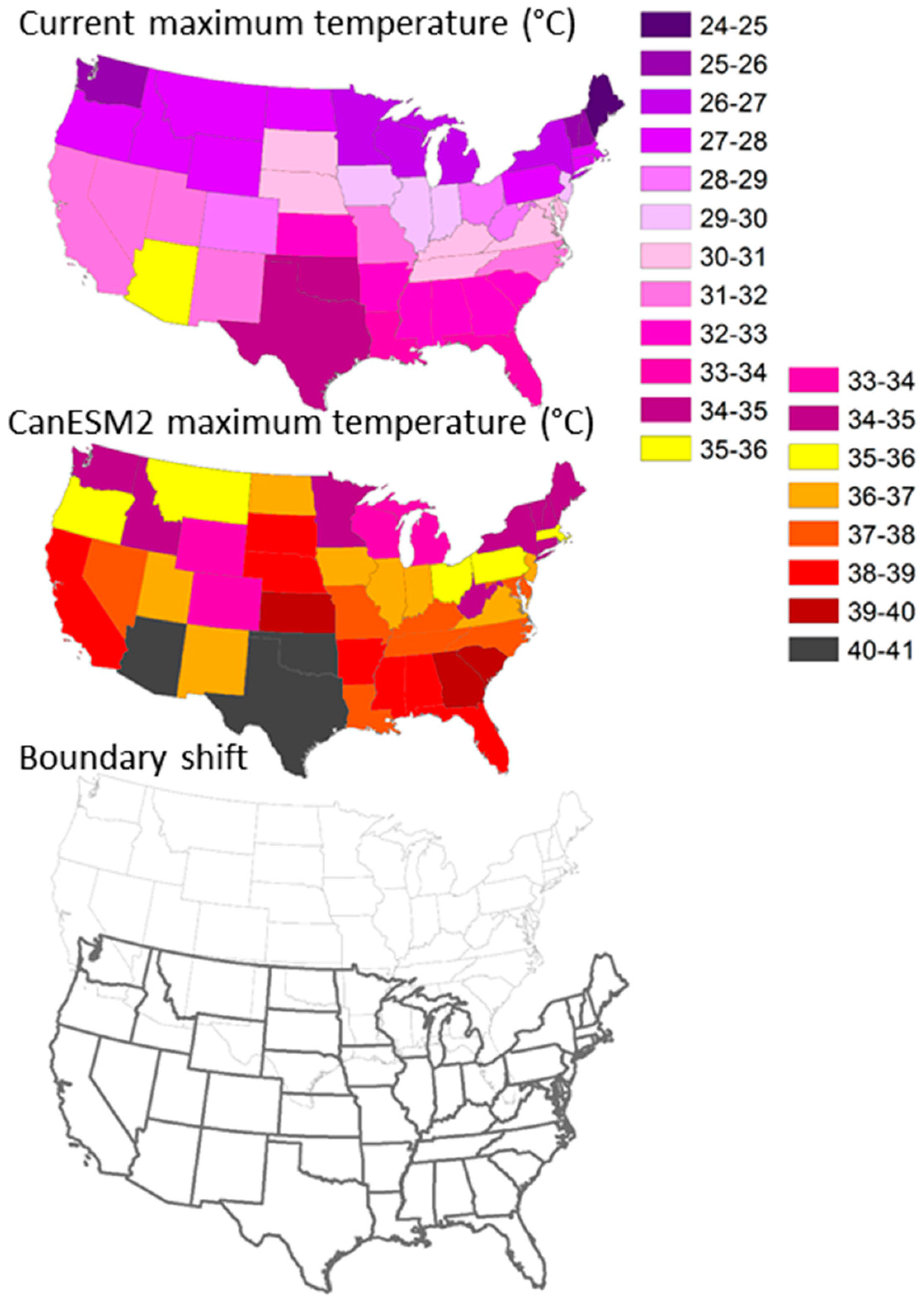Visualizing Current and Future Climate Boundaries of the Conterminous United States: Implications for Forests
Abstract
1. Introduction
2. Methods
3. Results
4. Discussion
4.1. Ecological Boundary Shifts
4.2. Implications
5. Conclusions
Supplementary Materials
Author Contributions
Funding
Acknowledgments
Conflicts of Interest
References
- Brysse, K.; Oreskes, N.; O’Reilly, J.; Oppenheimer, M. Climate change prediction: Erring on the side of least drama? Glob. Environ. Chang. 2013, 23, 327–337. [Google Scholar] [CrossRef]
- Peters, G.P.; Andrew, R.M.; Boden, T.; Canadell, J.G.; Ciais, P.; Le Quéré, C.; Marland, G.; Raupach, M.R.; Wilson, C. The challenge to keep global warming below 2 °C. Nat. Clim. Chang. 2012, 3, 4–6. [Google Scholar] [CrossRef]
- Lazard. Levelized Cost of Energy 2017. Available online: https://www.lazard.com/perspective/levelized-cost-of-energy-2017 (accessed on 1 September 2018).
- Kincer, J.B. Atlas of American Agriculture—Climate: Temperature, Sunshine, and Wind; U.S. Government Printing Office: Washington, DC, USA, 1928.
- Daly, C.; Widrlechner, M.P.; Halbleib, M.D.; Smith, J.I.; Gibson, W.P. Development of a New USDA Plant Hardiness Zone Map for the United States. J. Appl. Meteorol. Climatol. 2010, 51, 242–264. [Google Scholar] [CrossRef]
- Parker, L.E.; Abatzoglou, J.T. Projected changes in cold hardiness zones and suitable overwinter ranges of perennial crops over the United States. Environ. Res. Lett. 2016, 11, 34001. [Google Scholar] [CrossRef]
- Köppen, W. ; Volken, E.; Brönnimann, S., Translators; “Die Wärmezonen der Erde, nach der Dauer der heissen, gemässigten und kalten Zeit und nach der Wirkung der Wärme auf die organische Welt betrachtet” [The thermal zones of the earth according to the duration of hot, moderate and cold periods and to the impact of heat on the organic world)]. Meteorol. Zeitschrift 2011, 20, 351–360. [Google Scholar]
- Kottek, M.; Grieser, J.; Beck, C.; Rudolf, B.; Rubel, F. World map of the Köppen-Geiger climate classification updated. Meteorol. Zeitschrift 2006, 15, 259–263. [Google Scholar] [CrossRef]
- Belda, M.; Holtanová, E.; Halenka, T.; Kalvová, J. Climate classification revisited: From Köppen to Trewartha. Clim. Res. 2014, 59, 1–13. [Google Scholar] [CrossRef]
- Ackerman, E.A. The Köppen classification of climates in North America. Geogr. Rev. 1941, 31, 105–111. [Google Scholar] [CrossRef]
- Trewartha, G.T. An Introduction to Climate; McGraw-Hill: New York, NY, USA, 1968. [Google Scholar]
- Bailey, R.G. Description of the Ecoregions of the United States, 2nd ed.; Misc. Pub. No. 1391; USDA Forest Service: Washington, DC, USA, 1995.
- Livneh, B.; Rosenberg, E.A.; Lin, C.; Nijssen, B.; Mishra, V.; Andreadis, K.M.; Maurer, E.P.; Lettenmaier, D.P. A long-term hydrologically based dataset of land surface fluxes and states for the conterminous United States: Update and extensions. J. Clim. 2013, 26, 9384–9392. [Google Scholar] [CrossRef]
- Pierce, D.W.; Cayan, D.R.; Thrasher, B.L. Statistical downscaling using Localized Constructed Analogs (LOCA). J. Hydrometeorol. 2014, 15, 2558–2585. [Google Scholar] [CrossRef]
- De Castro, M.; Gallardo, C.; Jylha, K.; Tuomenvirta, H. The use of a climate-type classification for assessing climate change effects in Europe from an ensemble of nine regional climate models. Clim. Chang. 2007, 81, 329–341. [Google Scholar] [CrossRef]
- Patton, C.P. A note on the classification of dry climate in the Köppen system. Cal. Geogr. 1962, 3, 105–112. [Google Scholar]
- Cleland, D.T.; Avers, P.E.; McNab, W.H.; Jensen, M.E.; Bailey, R.G.; King, T.; Russell, W.E. National Hierarchical Framework of Ecological Units. In Ecosystem Management Applications for Sustainable Forest and Wildlife Resources; Boyce, M.S., Haney, A., Eds.; Yale University Press: New Haven, CT, USA, 1997; pp. 181–200. [Google Scholar]
- Veloz, S.; Williams, J.W.; Lorenz, D.; Notaro, M.; Vavrus, S.; Vimont, D.J. Identifying climatic analogs for Wisconsin under 21st-century climate-change scenarios. Clim. Chang. 2012, 112, 1037–1058. [Google Scholar] [CrossRef]
- Woodward, F.I.; Beerling, D.J. The dynamics of vegetation change: Health warnings for equilibrium “Dodo” models. Glob. Ecol. Biogeogr. Lett. 1997, 6, 413–418. [Google Scholar] [CrossRef]
- McKenney, D.W.; Pedlar, J.H.; Lawrence, K.; Papadopol, P.; Campbell, K.; Hutchinson, M.F. Change and evolution in the plant hardiness zones of Canada. Bioscience 2014, 64, 341–350. [Google Scholar] [CrossRef]
- Loehle, C. Height growth rate tradeoffs determine northern and southern range limits for trees. J. Biogeogr. 1998, 25, 735–742. [Google Scholar] [CrossRef]
- Molina-Montenegro, M.A.; Gallardo-Cerda, J.; Flores, T.S.M.; Atala, C. The trade-off between cold resistance and growth determines the Nothofagus pumilio treeline. Plant Ecol. 2012, 213, 133–142. [Google Scholar] [CrossRef]
- Carter, K.K. Provenance tests as Indicators of growth response to climate change in 10 north temperate tree species. Can. J. For. Res. 1996, 26, 1089–1095. [Google Scholar] [CrossRef]
- Svenning, J.-C.; Skov, F. Limited filling of the potential range in European tree species. Ecol. Lett. 2004, 7, 565–573. [Google Scholar] [CrossRef]
- Pulliam, H.R. Sources, sinks, and population regulation. Am. Nat. 1988, 132, 652–661. [Google Scholar] [CrossRef]
- Pulliam, H.R. On the relationship between niche and distribution. Ecol. Lett. 2002, 3, 349–361. [Google Scholar] [CrossRef]
- Davis, M.B.; Shaw, R.G. Range shifts and adaptive responses to Quaternary climate change. Science 2001, 292, 673–679. [Google Scholar] [CrossRef]
- Iverson, L.R.; Thompson, F.R.; Matthews, S.; Peters, M.; Prasad, A.; Dijak, W.D.; Fraser, J.; Wang, W.J.; Hanberry, B.; He, H.; et al. Multi-model comparison on the effects of climate change on tree species in the eastern U.S.: Results from an enhanced niche model and process-based ecosystem and landscape models. Landsc. Ecol. 2017, 32, 1327–1346. [Google Scholar] [CrossRef]
- Hanberry, B.B.; Hansen, M.H. Latitudinal range shifts of tree species in the United States across multi-decadal time scales. Basic Appl. Ecol. 2015, 16, 231–238. [Google Scholar] [CrossRef]
- Woodall, C.W.; Westfall, J.A.; D’Amato, A.W.; Foster, J.R.; Walters, B.F. Decadal changes in tree range stability across forests of the eastern U.S. For. Ecol. Manag. 2018, 429, 503–510. [Google Scholar] [CrossRef]
- Gleason, H.A. The vegetational history of the Middle West. Ann. Am. Assoc. Geogr. 1922, 12, 39–85. [Google Scholar] [CrossRef]
- Hanberry, B.B.; Hansen, M.H. Advancement of tree species across ecotonal borders into non-forested ecosystems. Acta Oecol. 2015, 68, 24–36. [Google Scholar] [CrossRef]
- Hanberry, B.B. Defining the historical northeastern forested boundary of the Great Plains grasslands in the United States. Prof. Geogr. in press.
- Hanberry, B.B.; Abrams, M.D.; White, J.D. Is increased precipitation during the 20th century statistically or ecologically significant in the eastern US? J. Land Use Sci. 2018, 13, 259–265. [Google Scholar] [CrossRef]
- Wells, P.V. Scarp woodlands, transported grassland soils, and concept of grassland climate in the Great Plains region. Science 1965, 148, 246–249. [Google Scholar] [CrossRef]
- Hanna, M.; Janne, K.; Perttu, V.; Helena, K. Gaps in the capacity of modern forage crops to adapt to the changing climate in northern Europe. Mitig. Adapt. Strateg. Glob. Chang. 2018, 23, 81–100. [Google Scholar] [CrossRef]
- Hansen, J.E.; Sato, M. Paleoclimate implications for human-made climate change. In Climate Change: Inferences from Paleoclimate and Regional Aspects; Berger, A., Mesinger, F., Šijački, D., Eds.; Springer: New York, NY, USA, 2012; pp. 21–48. [Google Scholar]
- Hsiang, S.; Kopp, R.; Jina, A.; Rising, J.; Delgado, M.; Mohan, S.; Rasmussen, D.J.; Muir-Wood, R.; Wilson, P.; Oppenheimer, M.; et al. Estimating economic damage from climate change in the United States. Science 2017, 356, 1362–1369. [Google Scholar] [CrossRef]




| Zone | Half Zone | Minimum °C (°F) | Maximum °C (°F) |
|---|---|---|---|
| 2 | a | −45.6 (−50) | −42.8 (−45) |
| b | −42.8 (−45) | −40 (−40) | |
| 3 | a | −40 (−40) | −37.2 (−35) |
| b | −37.2 (−35) | −34.4 (−30) | |
| 4 | a | −34.4 (−30) | −31.7 (−25) |
| b | −31.7 (−25) | −28.9 (−20) | |
| 5 | a | −28.9 (−20) | −26.1 (−15) |
| b | −26.1 (−15) | −23.3 (−10) | |
| 6 | a | −23.3 (−10) | −20.6 (−5) |
| b | −20.6 (−5) | −17.8 (0) | |
| 7 | a | −17.8 (0) | −15 (5) |
| b | −15 (5) | −12.2 (10) | |
| 8 | a | −12.2 (10) | −9.4 (15) |
| b | −9.4 (15) | −6.7 (20) | |
| 9 | a | −6.7 (20) | −3.9 (25) |
| b | −3.9 (25) | −1.1 (30) | |
| 10 | a | −1.1 (30) | +1.7 (35) |
| b | 1.7 (35) | 4.4 (40) | |
| 11 | a | 4.4 (40) | 7.2 (45) |
| b | 7.2 (45) | 10 (50) |
| Climate Types | Letter | Ruleset |
|---|---|---|
| Tropical (Savanna) | A | all months ≥ 18 °C |
| Subtropical and Mediterranean | C | 8–12 months ≥ 10 °C |
| Temperate | D | 4–7 months ≥ 10 °C |
| Hot Continental | Dca | warmest month ≥ 22 °C |
| Warm Continental | Dcb | coldest month < 0 °C, warmest month < 22 °C |
| Boreal | E | 1 to 3 months ≥ 10 °C |
| Polar | F | all months < 10 °C |
| Dry | B | mean annual precipitation < (2.3 T − 0.64 Pw + 41) a |
| Subtropical desert | Bwh | mean annual precipitation < 0.5·(2.3 T − 0.64 Pw + 41) a, all months ≥ 0 °C |
| Subtropical steppe | Bsh | mean annual precipitation ≥ 0.5·(2.3 T − 0.64 Pw + 41) a, all months ≥ 0 °C |
| Temperate desert | Bwk | mean annual precipitation < 0.5·(2.3 T − 0.64 Pw + 41) a, one or more months < 0 °C |
| Temperate steppe | Bsk | mean annual precipitation ≥ 0.5·(2.3 T − 0.64 Pw + 41) a, one or more months < 0 °C |
| Prairie | Pr | C or D, annual precipitation < 75 cm |
© 2019 by the authors. Licensee MDPI, Basel, Switzerland. This article is an open access article distributed under the terms and conditions of the Creative Commons Attribution (CC BY) license (http://creativecommons.org/licenses/by/4.0/).
Share and Cite
Hanberry, B.B.; Fraser, J.S. Visualizing Current and Future Climate Boundaries of the Conterminous United States: Implications for Forests. Forests 2019, 10, 280. https://doi.org/10.3390/f10030280
Hanberry BB, Fraser JS. Visualizing Current and Future Climate Boundaries of the Conterminous United States: Implications for Forests. Forests. 2019; 10(3):280. https://doi.org/10.3390/f10030280
Chicago/Turabian StyleHanberry, Brice B., and Jacob S. Fraser. 2019. "Visualizing Current and Future Climate Boundaries of the Conterminous United States: Implications for Forests" Forests 10, no. 3: 280. https://doi.org/10.3390/f10030280
APA StyleHanberry, B. B., & Fraser, J. S. (2019). Visualizing Current and Future Climate Boundaries of the Conterminous United States: Implications for Forests. Forests, 10(3), 280. https://doi.org/10.3390/f10030280





